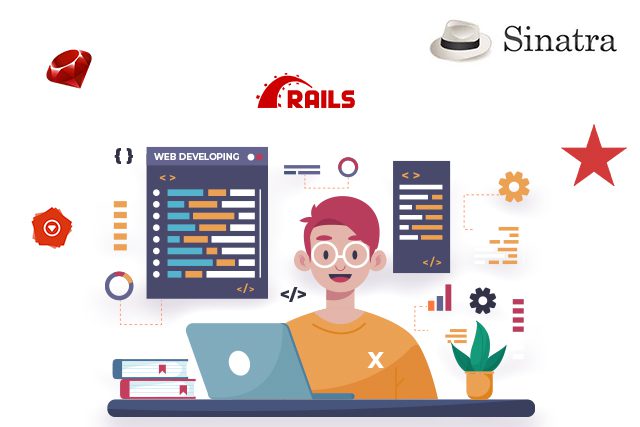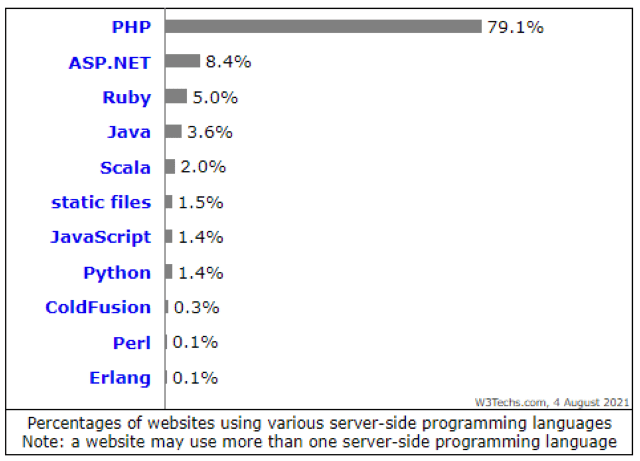
Ruby is a programming language that is often used to build websites. Developers like it because it is open source, flexible, and safe. MVC is built into the programming language, which makes the product easy to use. Let’s look at the best Ruby framework for building websites that is on the market.
Introduction
Ruby is a good language for creating cutting-edge apps since it prioritizes ease of use and efficiency. The system is about 30 years old, but it is filled with cutting-edge features and is relied on by developers.
Nowadays, Ruby is mostly used to build scalable, reliable web applications. Because of its low cost, scalability, and security, the language is ideal for online marketplaces.
You are able to build websites like Airbnb and even some of the technological powerhouses have faith in Ruby and use it in their development process, like Github, Apple, Netflix, and many more.
Because Ruby is becoming more and more popular, some smart programmers have made cutting-edge tools to help developers test their code.
Some frameworks aim to streamline the request-response cycle and application middleware. Some of the frameworks can help you out with designing REST APIs, and there are more that are intended for web apps. In this article, we’ll go over the best Ruby frameworks from around the world and how each one helps programmers make the most of Ruby. Ruby is praised because it has a syntax that is both simple and rich. This makes it possible for Dedicated Ruby Developers to make more with less code.
But let’s first learn more about Ruby on Rails.
What is Ruby?
Ruby’s versatility and portability make it a popular choice among developers.
Desktop apps, static websites, data processing services, and automation solutions are all areas where Ruby shines. utilized in web hosting, DevOps, data mining, and crawling the web. Also, the Rails application framework makes it possible to do a lot more, especially with database-driven web apps.
Ruby is one of the top three server-side or backend programming languages today, according to W3techs. It was made 26 years ago.

Why Ruby?
- It allows for the quick release of web apps.
- Budgets can be better protected when using Ruby.
- It is able to manage and avoid migration complications.
- Application runs more quickly and securely thanks to Ruby.
- If we want to add new functionality to an app, it can do it quickly and efficiently.
- It employs meta programming strategies for coding.
Features of Ruby
- Object-oriented
- Mixins
- Dynamic typing and Duck typing
- Garbage collector
- Statement delimiters
- Simple Testing Tool
- Automated Deployment
- Simple Programming Language
Now, when you know about Ruby and its features. Let’s take a deep dive into the top Ruby frameworks.
Top Ruby Framework
1. Ruby on rails
When it comes to Ruby frameworks, nobody can beat Ruby on Rails. Services related to building applications with the Rails framework make up 86% of the Ruby framework market.
Ruby on Rails has been around for more than 15 years, which has given it a lot of time to grow and a large user base from which to pull developers. including components that make it easier to create an MVP (Minimum Viable Product) prototype that can be scaled up in the future.
Many big companies, including Twitter, have chosen Ruby on Rails as their main programming language. The social networking site’s community presence and user experience benefited greatly from it.
You can find a dedicated RoR developer in the United States for a costly price. An onshore development company like this produces high-quality results. However, due to the more powerful currency, these companies are expensive. Conversely, you can find industry-leading professionals from ruby on rails development company to have a much more budget-friendly solution.
It is important to note that the Ruby on Rails development services you choose will divide your project into three parts—the model, the view, and the controller. The reason for this is that their model-view-controller architecture (MVC) streamlines development and gives your developer the ability to create the app components with greater ease.
2. Sinatra
When it comes to the building of websites using Ruby, Sinatra is among the most widely used of all the available frameworks. It was built with simplicity and ease of use in mind using Ruby. Web developers frequently use Sinatra as an alternative to Ruby on Rails.
It has a basic DSL modem built in (Domain Specific Language). As a result, the Ruby code jumps straight from the URL path of the request. People have said that Sinatra is a great alternative if you’d rather use a simpler but more general framework.
Sinatra provides a solid platform on which to build a variety of different apps. It is a feasible choice for applications that may eventually transition to a more robust framework like Rails, and it is suitable for those applications.
3. Ramaze
When it comes to developing high-quality websites, Ramaze is among the best Ruby web frameworks available. Because of its low weight, Ramaze is quicker and has a less steep learning curve. If your Ruby software requires a template engine, ORM, JavaScript, or AJAX, Ramaze is a solid choice. Ramaze is widely recognized as a powerful and “bug-free” framework.
The developers are so sure that this framework will function with any ORM that they’ve included a compliance facility for users that run into issues.
It aims to be one of the most user-friendly frameworks available. In order to ensure the greatest level of convenience, this aids users in keeping their learning pace constant. It is widely considered to be one of the best web frameworks available today.
4. Cuba
Cuba, a lightweight web framework, was inspired by Rum, a small but effective mapper for Rack programs.
This is arguably the best Ruby framework available because it avoids the MVC approach. If your web app needs it, you can use a model or controller from a different framework, like ActiveRecord, if you have one.Cuba is a real-time program that can be used to build eCommerce and landing page websites.
Many safety measures are also present in Cuba. To use them, put “Cuba.use Rack::Protection” at the beginning of the source code for your application. This stops the vast majority of attacks in their tracks. Template support is also embedded right in.
5. Hanami
Hanami promotes the development of applications from a wide range of modular components. These modules, which make up a significant part of the current framework, can be used independently of the framework as a whole.
Hanami’s advantages include reduced response times, improved performance, and the promise of 60% less memory usage compared to similar Ruby frameworks. You, as an app developer, cannot ignore these advantages. It also provides developers with more leeway because it is less constrained than Rails.
If developers want to take a different approach than what is often done with Rails while keeping a full-fledged framework architecture, Hanami is an option that is worth investigating further.
6. Goliath
Goliath is considered to be one of the greatest Ruby frameworks since it places less emphasis on the “development” component than the others on this list. PostRank is run by Goliath, which is a lightweight web server framework that focuses on server-side methods.
The Rack Application Programming Interface, Ruby middleware, and asynchronous processing are all examples. Event-driven architecture is emphasized in Goliath since the EventMachine reactor is the system’s backbone.
Goliath is also open-source, which has helped its linear development over time in a big way. Working with Goliath will be a wonderful experience for you if you have an interest in Ruby web-server programming.
7. Padrino
While it might be seen as a logical extension of Sinatra’s, Padrino’s is a complete framework in its own right. Sinatra is a microframework, but with the help of Padrino, it can be turned into a full-framework platform for making complex online applications.
Padrino maintains the same minimalistic aesthetic, rapid speed, and lightweight build as Sinatra. The updated framework makes an effort to maintain existing characteristics while introducing new ones.
The fact that Padrino works with any kind of program is probably its best selling point. The framework doesn’t come with any libraries for testing, mocking, or other special functions. Instead, the developer is given the freedom to start the project with their own preferences and needs in mind.
8. Grape
A little Ruby framework that works well with Rails and Sinatra. They consider it to be the best language out there.
The conventions like content negotiation, subdomain/prefix restriction, versioning, and support for a wide variety of formats are all supported by Grape, a Ruby framework. It provides web application developers with APIs that are relevant, efficient, and effective.
It was made to be a well-organized framework, which means that it pushes developers to achieve their goals in a certain way. Keep an eye on it for the future, and if you’re planning a project, you might want to learn more about it now.
9. Scorched
Scorched is another one of the best ruby web frameworks that requires Ruby 2.0 and above to work. Scorched is light-weight, and the official website states Scorched as “true evolutionary enhancement of Sinatra, with more power, focus, and less clutter.”
Scorched developers have assumed that since Scorched is on top of Rack, the fellow developers are already familiar with it. With that effect, they have removed any “overlapping” functionality and kept Scorched simplified and concrete in its working..
10. NYNY
A “small” ruby framework called NYNY is also thought to be one of the best ruby frameworks because of how it works.
The “small” refers to the 300 lines of code created by NYNY that have been so helpful to Ruby Web Development Company. In comparison to other Ruby frameworks, it has a lot fewer lines of code. There are more parts to other Ruby web frameworks than there are in NYNY.
comprehensiveness and recentness. Most Ruby on Rails development companies in India use NYNY because it has a lot of information and is up-to-date. In this situation, the developer can change the framework to add any new features they want.
The best part of the NYNY app is that it works well with other Rack-based applications like Rails and Sinatra. The helpful people in the NYNY community make it easy to get to the web server’s valuable information.
Wrapping it up
Ruby is the most powerful programming language that is currently available, and it is widely used for web development. We’ve put together a list of the best Ruby frameworks for quickly building websites.
You can use one of these ten Ruby frameworks to make anything from a simple blog to a complicated web app for big businesses.
About Author:-
Archit has been working as Technical Content Manager & Digital Marketing Expert with WPWeb Infotech. He is a passionate content writer and has a love for WordPress so he spends a significant amount of time writing about it. He has a deep knowledge and interest to work with new marketing strategies. In his free time, he loves to watch Cricket, read spiritual and marketing books, and play music.
